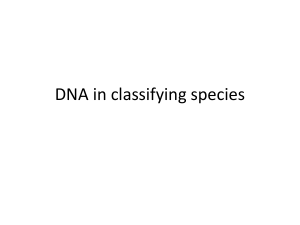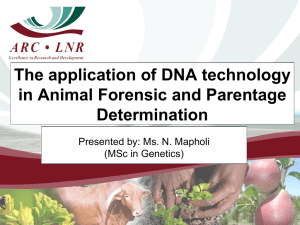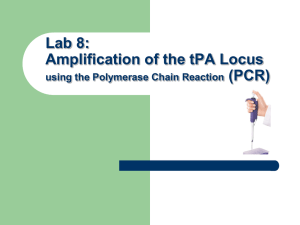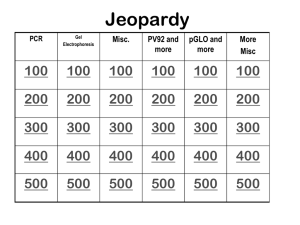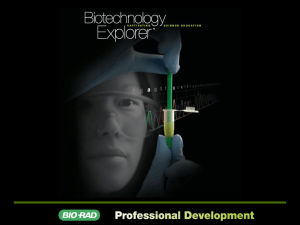in real time
advertisement
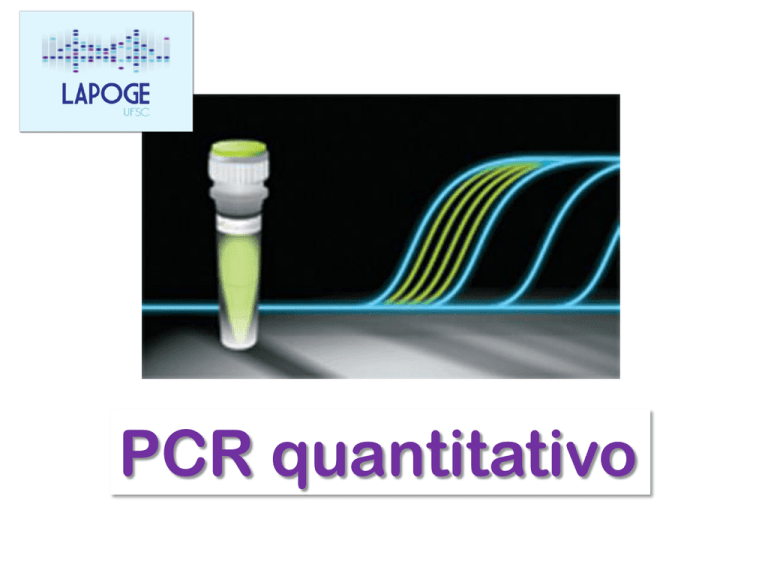
PCR quantitativo What is Real-Time PCR? Real-Time PCR is a specialized technique that allows a PCR reaction to be visualized “in real time” as the reaction progresses. This enables researchers to quantify the amount of DNA in the sample at the start of the reaction! What is Real-Time PCR? Differences with normal PCR? • 20ul PCR reactions • SYBR Green or probes 94°C 4 min 94°C 15 sec 40x 61°C 30 sec 72°C 30 sec What is Real-Time PCR used for? Real-Time PCR has become a cornerstone of molecular biology: • Gene expression analysis – Medical research – Drug research • Disease diagnosis – Viral quantification • Food testing – Percent GMO food • Transgenic research – Gene copy number What is Real-Time PCR? Taq polymerase can only synthesize DNA, so how do we study gene expression (RNA) using qPCR? Reverse transcription RNA -> DNA (cDNA) What’s Wrong With Agarose Gels? Low sensitivity Low resolution Non-automated Size-based discrimination only Results are not expressed as numbers based on personal evaluation Ethidium bromide staining is not very quantitative End point analysis Endpoint analysis Different concentrations give similar endpoint results! …So that’s how PCR is usually presented. Imagining Real-Time PCR To understand real-time PCR, let’s imagine ourselves in a PCR reaction tube at cycle number 25… Imagining Real-Time PCR What’s in our tube, at cycle number 25? A soup of nucleotides, primers, template, amplicons, enzyme, etc. ~1,000,000 copies of the amplicon right now. Imagining Real-Time PCR How did we get here? What was it like last cycle, 24? Almost exactly the same, except there were only 500,000 copies of the amplicon. And the cycle before that, 23? Almost the same, but only 250,000 copies of the amplicon. And what about cycle 22? Not a whole lot different. 125,000 copies of the amplicon. Imagining Real-Time PCR If we were to graph the amount of DNA in our tube, from the start until right now, at cycle 25, the graph would look like this: 2000000 1800000 How did we get here? 1600000 1400000 1200000 1000000 800000 600000 400000 200000 0 0 5 10 15 20 25 30 35 40 Imagining Real-Time PCR So where are we going? What’s it going to be like after the next cycle, in cycle 26? Probably there will be 2,000,000 amplicons. And cycle 27? Maybe 4,000,000 amplicons. And at cycle 200? In theory, there would be 1,000,000,000,000,000,000,000,000,000,000,000,000,000,000,000 ,000,000,000,000 amplicons… ? 2000000 1800000 1600000 1400000 1200000 1000000 800000 600000 400000 200000 0 0 5 10 15 20 25 30 35 40 Imagining Real-Time PCR If we plot the amount of DNA in our tube going forward from cycle 25, we see that it actually looks like this: 5000000 4500000 So where are we going? 4000000 3500000 3000000 2500000 2000000 1500000 1000000 500000 0 0 • • 5 10 15 20 25 30 35 40 Realistically, at the chain reaction progresses, it gets exponentially harder to find primers, and nucleotides. And the polymerase is wearing out. So exponential growth does not go on forever! Imagining Real-Time PCR Measuring Quantities How can all this be used to measure DNA quantities?? What if YOU started with FOUR times as much DNA template as I did? I have 1,000,000 copies at cycle 25. You have 4,000,000 copies! So… You had 2,000,000 copies at cycle 24. And… You had 1,000,000 copies at cycle 23. Imagining Real-Time PCR So… if YOU started with FOUR times as much DNA template as I did… Then you’d reach 1,000,000 copies exactly TWO cycles earlier than I would! 5000000 4500000 4000000 Measuring Quantities 3500000 3000000 2500000 2000000 1500000 1000000 500000 0 0 5 10 15 20 25 30 35 40 Imagining Real-Time PCR What if YOU started with EIGHT times LESS DNA template than I did? You’d only have 125,000 copies right now at cycle 25… …and you’ll have 250,000 at 26, 500,000 at 27, and by cycle 28 you’ll have caught up with 1,000,000 copies! So… you’d reach 1,000,000 copies exactly THREE cycles later than I would! 5000000 4500000 Measuring Quantities 4000000 3500000 3000000 2500000 2000000 1500000 1000000 500000 0 0 5 10 15 20 25 30 35 40 The “ct value” Imagining Real-Time PCR • • The value that represents the cycle number where the amplification curve crosses an arbitrary threshold. Ct values are directly related to the starting quantity of DNA, by way of the formula: Quantity = 2^Ct 5000000 Ct Values: 4500000 Measuring Quantities 4000000 3500000 25 23 3000000 28 2500000 Threshold 2000000 1500000 1000000 500000 0 0 5 10 15 20 25 30 35 40 threshold Ct Imagining Real-Time PCR There’s a DIRECT relationship between the starting amount of DNA, and the cycle number that you’ll reach an arbitrary number of DNA copies (Ct value). DNA amount = 2 ^ Cycle Number C o p y N u m b e r v s. C t - St a n d a r d C u r v e 40 35 y = R 25 Ct Measuring Quantities 30 -3 . 3 1 9 2 x + 2 = 3 9 .77 2 0 .9 9 6 7 20 15 10 5 0 0 1 2 3 4 5 6 7 L o g o f c o p y n u m b e r (1 0 n ) 8 9 10 11 How do We Measure DNA in a PCR Reaction? We use reagents that fluoresce in the presence of amplified DNA! Ex. SYBR Green dye They bind to double-stranded DNA and emit light when illuminated with a specific wavelength. SYBRgreen How do We Measure DNA in a PCR Reaction? • dsDNA intercalating dye • Unspecific (optimization) • cheap 3’ 5’ 5’ 3’ Extension ID 3’ 5’ Taq ID ID Taq 5’ ID ID 3’ Apply Excitation Wavelength l l 3’ l ID ID ID Taq l ID ID l Taq 5’ 3’ Melting curve – Test the presence of unspecific amplification, contamination, primer dimers,.. TaqMan probes • Sequence-specific • Doesn´t need much optimization • More expensive What Type of Instruments are used with RealTime PCR? Real-time PCR instruments consist of TWO main components: • Thermal Cycler (PCR machine) • Optical Module (to detect fluorescence in the tubes during the run) What Type of Instruments are used with RealTime PCR? • Adequate, optical plates 96/384 wells Standard/fast • Optical sealing adhesive Quantification and Normalization • First basic underlying principle: every cycle there is a doubling of product. Quantification and Normalization • Second basic principle: we do not need to know exact quantities of DNA, instead we will only deal with relative quantities. 5000000 4500000 4000000 3500000 3000000 2500000 2000000 1500000 1000000 500000 0 0 5 10 15 20 25 30 35 40 • Third basic principle: we have to have not only a “target” gene but also a “normalizer” gene. • Key formula: Quantity = 2 ^ (Cta – Ctb) Standard Curve Quantification and Normalization 5000000 4500000 4000000 3500000 3000000 2500000 2000000 1500000 1000000 500000 0 0 5 10 15 20 25 30 35 40 Prepare a 2-fold serial dilution of a DNA sample: Recomendation: add always a standard curve in every run “normalizer” gene Quantification and Normalization 5000000 4500000 4000000 3500000 3000000 2500000 2000000 1500000 1000000 500000 • Knowing the amount of mRNA in one sample from one specific gene does not tell us much.. • You need to know the total amount of mRNA in your sample • You also dont know how much the mRNA level has changed compared to other mRNA levels • Example: mRNA levels of a gene increase 2x after induction 0 0 5 10 15 20 25 30 35 40 It is possable that all (1) genexpression in the cell has increased (2) the induced samples contained more total mRNA We have to compare the expression of our gene to another gene which expression is normally constant, a housekeeping gene (ex. TBP, 18S) ΔΔCt method experiment control -[(Cttg-Ctcg)-(Cttg-Ctcg)] 2 Ex! Ct = target gene– ref gene Ct = 9.70 Ct = target gene– ref gene Ct = -1.70 Difference = Ct-Ct = Ct = 9.70-(-1.7) = 11.40 Fold change = 211.40 = 2702 Always in duplicate or triplicate! Quanto aos primers.. • Para qPCR: Iniciadores que flanqueiam a junção exon-exon para evitar amplificação inespecífica devido à contaminação por gDNA. • Sempre testar os primers pela 1ª vez por PCR normal em pelo menos 3 diferentes temperaturas e correr gel! Escolher a máxima temperatura em que há apenas 1 banda (e do tamanho esperado!) e a amplificação ainda é satisfatoria! Calculando a eficiência dos primers em qPCR Ideal: N = N0.2n N = número de moléculas amplificadas N0 = número de moléculas inicial n = Número de ciclos threshold Ct Curva padrão threshold SERIES OF 10-FOLD DILUTIONS 15 10,000,000,000 100% EFF 90% EFF 80% EFF 70% EFF AMOUNT OF DNA 1,000,000,000 100,000,000 10,000,000 1,000,000 100,000 10,000 1,000 100 10 1 0 10 20 PCR CYCLE NUMBER E = 10^(-1/slope) E = (10^(-1/slope)-1)*100 Ex. slope = -3,81 Eficiência = (10^(-1/-3.81)-1)*100 = 83% Ideal: eficiência >95% 30 CYCLE AMOUNT OF DNA AMOUNT OF DNA AMOUNT OF DNA AMOUNT OF DNA 100% EFFICIENCY 90% EFFICIENCY 80% EFFICIENCY 70% EFFICIENCY 0 1 1 1 1 1 2 2 2 2 2 4 4 3 3 3 8 7 6 5 4 16 13 10 8 5 32 25 19 14 6 64 47 34 24 7 128 89 61 41 8 256 170 110 70 9 512 323 198 119 10 1,024 613 357 202 11 2,048 1,165 643 343 12 4,096 2,213 1,157 583 13 8,192 4,205 2,082 990 14 16,384 7,990 3,748 1,684 15 32,768 15,181 6,747 2,862 16 65,536 28,844 12,144 4,866 17 131,072 54,804 21,859 8,272 18 262,144 104,127 39,346 14,063 19 524,288 197,842 70,824 23,907 20 1,048,576 375,900 127,482 40,642 21 2,097,152 714,209 229,468 69,092 22 4,194,304 1,356,998 413,043 117,456 23 8,388,608 2,578,296 743,477 199,676 24 16,777,216 4,898,763 1,338,259 339,449 25 33,554,432 9,307,650 2,408,866 577,063 26 67,108,864 17,684,534 4,335,959 981,007 27 134,217,728 33,600,615 7,804,726 1,667,711 28 268,435,456 63,841,168 14,048,506 2,835,109 29 536,870,912 121,298,220 25,287,311 4,819,686 30 1,073,741,824 230,466,618 45,517,160 8,193,466 35 1 1 Results? 2.5 Good experimental design Optimal primers Good RNA Good cDNA Relative gene expression log10 of relative gene expresion 2 1.5 Adequate nr of samples Adequate nr of replicates 1 0.5 0 Good STATISTICS -0.5 -1 -1.5 Treatment Gene A B C D E F G UCE Value 1.828745739 2.04179718 0.666738198 1.999855536 - 0.450673805 0.509327854 - 1.195371388 0 Call up regulated up regulated unaffected up regulated unaffected unaffected down regulated control gene





